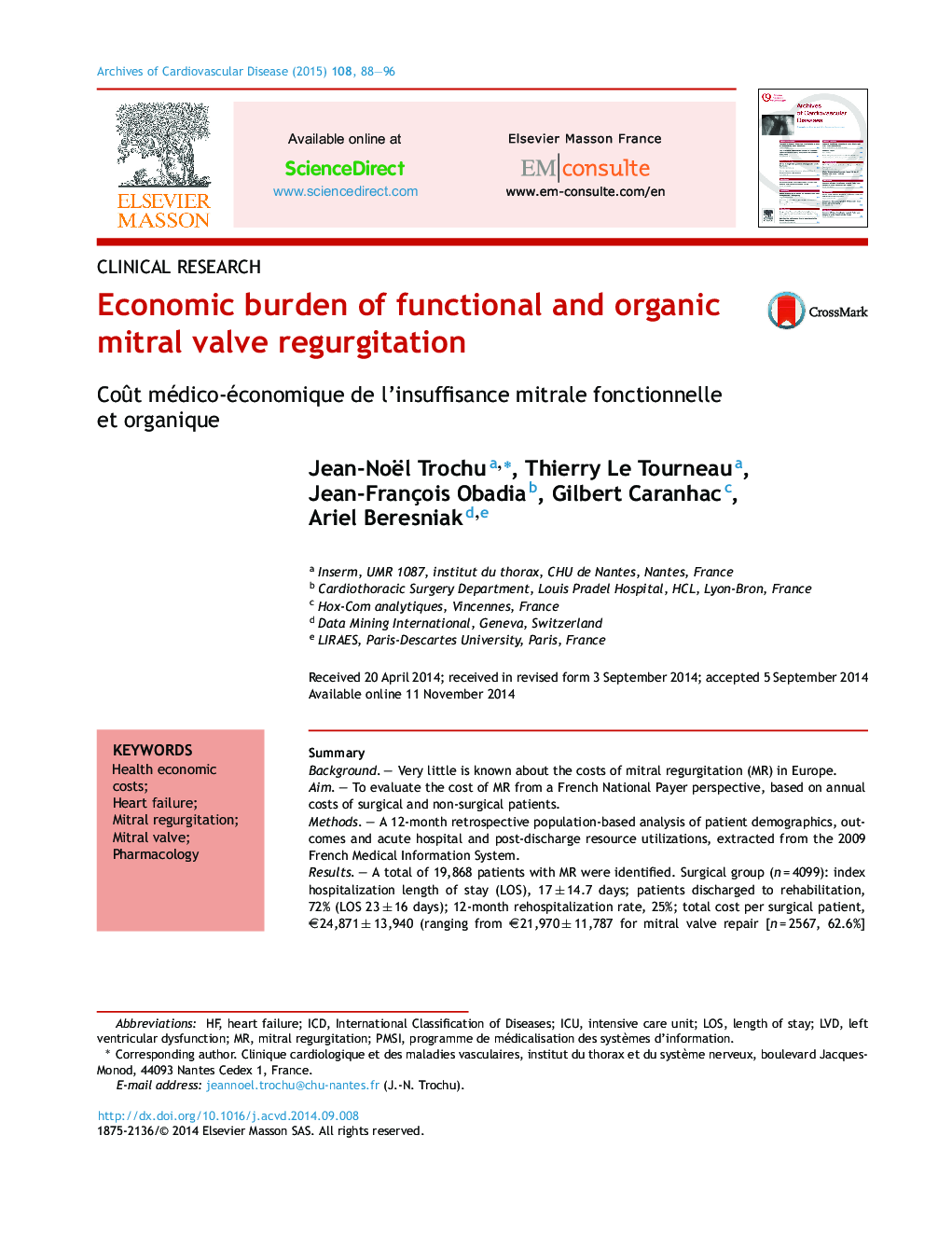| کد مقاله | کد نشریه | سال انتشار | مقاله انگلیسی | نسخه تمام متن |
|---|---|---|---|---|
| 2888881 | 1574347 | 2015 | 9 صفحه PDF | دانلود رایگان |
SummaryBackgroundVery little is known about the costs of mitral regurgitation (MR) in Europe.AimTo evaluate the cost of MR from a French National Payer perspective, based on annual costs of surgical and non-surgical patients.MethodsA 12-month retrospective population-based analysis of patient demographics, outcomes and acute hospital and post-discharge resource utilizations, extracted from the 2009 French Medical Information System.ResultsA total of 19,868 patients with MR were identified. Surgical group (n = 4099): index hospitalization length of stay (LOS), 17 ± 14.7 days; patients discharged to rehabilitation, 72% (LOS 23 ± 16 days); 12-month rehospitalization rate, 25%; total cost per surgical patient, €24,871 ± 13,940 (ranging from €21,970 ± 11,787 for mitral valve repair [n = 2567, 62.6%] to €29,732 ± 15,796 for mitral valve replacement). Non-surgical group (n = 15,769): number of hospitalizations over 12 months, 3.1 ± 1.5 (LOS 23.5 ± 20.4 days); admitted to rehabilitation, 24% (LOS 38.8 ± 37.6 days); total cost per patient, €12,177 ± 10,913 (varying between €9957 ± 9080 and €13,538 ± 11,692 for those without and with heart failure [HF], respectively). The total observed cost for 19,868 MR patients over 12 months was €292.8 million: surgical group, €100.8 million; medical group €192.0 million. Patients with MR and HF who were managed medically consumed 45% (€132.3 million) of the overall annual cost of MR.ConclusionThe costs of care associated with MR are highly heterogeneous. There are significant differences in costs and resources used between the surgical and medical MR subgroups, with further differences depending on type of surgery and presence of HF.
RésuméContexteLa connaissance du coût médico-économique de l’insuffisance mitrale reste très limitée en Europe.ObjectifÉvaluer le coût de l’IM en se basant sur l’étude des coûts annuels rattachés à la prise en charge médicale des patients opérés et non opérés.MéthodesIl s’agit d’une étude rétrospective qui a recueilli à partir des données du PMSI de 2009 et un suivi de 12 mois les données démographiques, les événements cliniques, les hospitalisations non programmées et l’utilisation des ressources médicales des patients ayant un diagnostic principal ou secondaire d’insuffisance mitrale.RésultatsDix-neuf mille huit cent soixante-huit patients avec IM ont été identifiés. Groupe chirurgical (n = 4099) : la durée de l’hospitalisation index (LOS) était de 17 ± 14,7 jours ; 72 % des patients étaient ensuite hospitalisés en centre de réadaptation (LOS 23 ± 16 jours) ; le taux de réhospitalisations à 12 mois était de 25 % ; le coût total moyen par patient chirurgical était de 24 871 ± 13 940 €, allant de 21 970 ± 11 787 € pour la réparation valvulaire mitrale (n = 2567, 62,6 %) à 29 732 ± 15 796 € pour le remplacement valvulaire. Groupe non chirurgical (n = 15 769) : les patients ont été hospitalisés en moyenne 3,1 ± 1,5 fois sur une période de 12 mois (LOS 23,5 ± 20,4 jours) ; 24 % ont été admis dans un centre de réadaptation (LOS 38,8 ± 37,6 jours) ; le coût total moyen par patient était de 12 177 ± 10 913 €, variant entre 9957 ± 9080 € à 13 538 ± 11 692 € respectivement selon la présence ou l’absence d’insuffisance cardiaque. Le coût total des 19 868 patients avec insuffisance mitrale pendant 12 mois était de 292,8 millions : 100,8 millions € pour le groupe chirurgical et 192,0 millions € pour le groupe médical. Les patient avec IM et insuffisance cardiaque pris en charge médicalement consommaient 45 % (132,3 millions €) du coût total annuel rattaché à l’insuffisance mitrale.ConclusionLes coûts médico-économiques et l’utilisation des ressources médicales associés à l’insuffisance mitrale sont très hétérogènes : des différences significatives existent entre les sous-groupes des patients opérés et les patients traités médicalement, avec également des différences selon le type de chirurgie et la présence d’une insuffisance cardiaque.
Journal: Archives of Cardiovascular Diseases - Volume 108, Issue 2, February 2015, Pages 88–96
